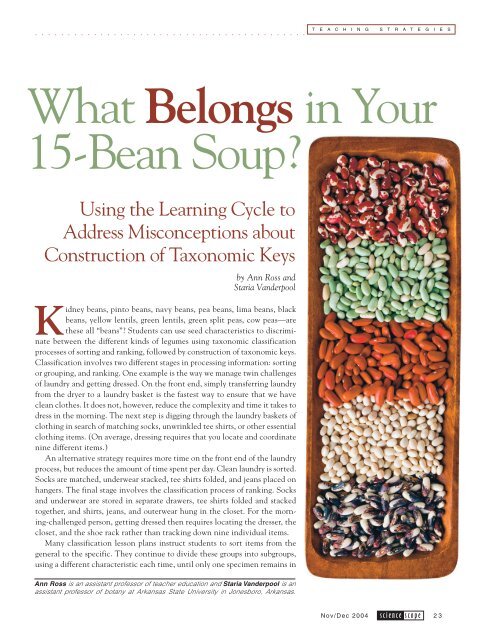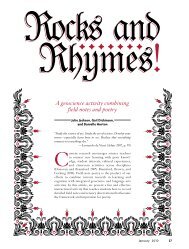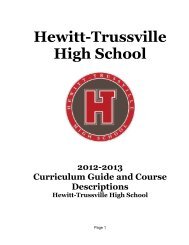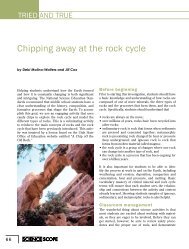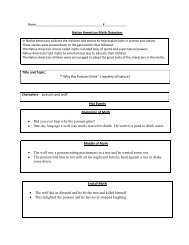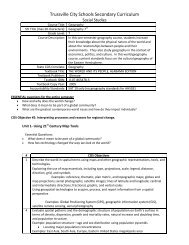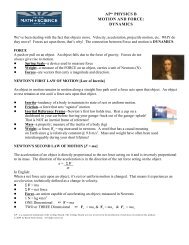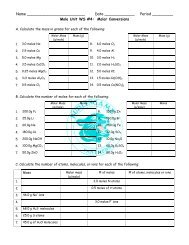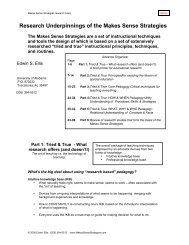WhatBelongsin Your 15-Bean Soup? - NSTA Learning Center
WhatBelongsin Your 15-Bean Soup? - NSTA Learning Center
WhatBelongsin Your 15-Bean Soup? - NSTA Learning Center
Create successful ePaper yourself
Turn your PDF publications into a flip-book with our unique Google optimized e-Paper software.
○ ○ ○ ○ ○ ○ ○ ○ ○ ○ ○ ○ ○ ○ ○ ○ ○ ○ ○ ○ ○ ○ ○ ○ ○ ○ ○ ○ ○ ○ ○ ○ ○ ○ ○ ○ ○ ○ ○ ○ ○ ○<br />
T E A C H I N G S T R A T E G I E S<br />
What Belongs in <strong>Your</strong><br />
<strong>15</strong>-<strong>Bean</strong> <strong>Soup</strong>?<br />
Using the <strong>Learning</strong> Cycle to<br />
Address Misconceptions about<br />
Construction of Taxonomic Keys<br />
by Ann Ross and<br />
Staria Vanderpool<br />
Kidney beans, pinto beans, navy beans, pea beans, lima beans, black<br />
beans, yellow lentils, green lentils, green split peas, cow peas—are<br />
these all “beans”? Students can use seed characteristics to discriminate<br />
between the different kinds of legumes using taxonomic classification<br />
processes of sorting and ranking, followed by construction of taxonomic keys.<br />
Classification involves two different stages in processing information: sorting<br />
or grouping, and ranking. One example is the way we manage twin challenges<br />
of laundry and getting dressed. On the front end, simply transferring laundry<br />
from the dryer to a laundry basket is the fastest way to ensure that we have<br />
clean clothes. It does not, however, reduce the complexity and time it takes to<br />
dress in the morning. The next step is digging through the laundry baskets of<br />
clothing in search of matching socks, unwrinkled tee shirts, or other essential<br />
clothing items. (On average, dressing requires that you locate and coordinate<br />
nine different items.)<br />
An alternative strategy requires more time on the front end of the laundry<br />
process, but reduces the amount of time spent per day. Clean laundry is sorted.<br />
Socks are matched, underwear stacked, tee shirts folded, and jeans placed on<br />
hangers. The final stage involves the classification process of ranking. Socks<br />
and underwear are stored in separate drawers, tee shirts folded and stacked<br />
together, and shirts, jeans, and outerwear hung in the closet. For the morning-challenged<br />
person, getting dressed then requires locating the dresser, the<br />
closet, and the shoe rack rather than tracking down nine individual items.<br />
Many classification lesson plans instruct students to sort items from the<br />
general to the specific. They continue to divide these groups into subgroups,<br />
using a different characteristic each time, until only one specimen remains in<br />
Ann Ross is an assistant professor of teacher education and Staria Vanderpool is an<br />
assistant professor of botany at Arkansas State University in Jonesboro, Arkansas.<br />
Nov/Dec 2004<br />
science scope<br />
23
○ ○ ○ ○ ○ ○ ○ ○ ○ ○ ○ ○ ○ ○ ○ ○ ○ ○ ○ ○ ○ ○ ○ ○ ○ ○ ○ ○ ○ ○ ○ ○ ○ ○ ○ ○ ○ ○ ○ ○ ○ ○ ○ ○ ○ ○ ○<br />
T E A C H I N G S T R A T E G I E S<br />
each group. Then they are instructed to devise and<br />
test a dichotomous key. This is a standard approach<br />
used in many classrooms. The value of this activity<br />
is indicated by numerous and innovative techniques<br />
for implementing hands-on classification activities<br />
using jelly beans, cars, or potato chips, for example.<br />
Standard classification activities lead to development<br />
of skills such as observing, interpreting variability,<br />
and sorting related objects into groups. However,<br />
biological classification systems utilize two<br />
separate information-processing stages—sorting and<br />
ranking. Construction of keys that allow others to<br />
discriminate the same groups is just one product of<br />
biological taxonomy. The primary product is a classification<br />
scheme that mirrors the biologist’s understanding<br />
of the historical evolutionary relationships<br />
among similar species. Standard classroom<br />
activities that only involve sorting can lead to misconceptions<br />
about biological classification of organisms<br />
because they leap from sorting to naming,<br />
omitting the ranking process.<br />
A second misconception is that keys are derived<br />
from a classification. Keys are logical devices constructed<br />
by experts that allow others to easily identify<br />
unknown objects. A key allows a user to match<br />
an unknown object with its name, which is not a<br />
function of the classification system. A classification<br />
system reflects the degree of relatedness among the<br />
included species.<br />
One approach to teaching concepts and addressing<br />
misconceptions is the <strong>Learning</strong> Cycle. The <strong>Learning</strong><br />
Cycle was introduced in the 1960s as an inquirybased<br />
teaching technique consisting of three stages:<br />
Exploration, Concept Introduction, and Application<br />
(Beisenherz and Dantonio 1996). The Exploration<br />
phase consists of unstructured, hands-on activities<br />
leading to observations and data collection. The<br />
teacher can identify misconceptions by listening carefully<br />
as students explain their observations. In the<br />
Concept Introduction stage, the scientific concept<br />
that explains what students observed in the first stage<br />
is introduced, including appropriate vocabulary. The<br />
teacher may use textbooks or other materials to<br />
present the concept. In the Application phase, students<br />
pursue more focused<br />
activities that reinforce or<br />
extend basic concepts. The<br />
<strong>Learning</strong> Cycle can be used<br />
Explore classification at<br />
www.scilinks.org.<br />
Enter code SS110401.<br />
to address some of the misconceptions<br />
about biological<br />
classification.<br />
FIGURE 1<br />
Secret sort, Exploration phase<br />
Objective<br />
Students will collect and sort materials gathered from their<br />
environment.<br />
Materials (per group of four students)<br />
one shopping bag<br />
two or three 100-cm lengths of yarn<br />
three index cards<br />
newspaper to cover table<br />
small objects collected by students<br />
Procedure<br />
1. Divide students into groups of four and give each group a<br />
shopping bag.<br />
2. Explain to students that you want each group to collect as<br />
many small objects lying on the ground as possible during a<br />
<strong>15</strong>-minute walk in an assigned schoolyard area. The entire<br />
collection should fit inside the shopping bag.<br />
Safety note: Students should be cautioned to avoid<br />
collecting live animals, animal droppings, broken glass,<br />
or sharp objects. If poison ivy, poison oak, or poison<br />
sumac are present in the collection area, students should be<br />
shown which plants to avoid.<br />
3. In the classroom, students spread newspapers over the<br />
desktops, then sort their materials into separate piles, or<br />
categories. They use the yarn to form loops to enclose groups<br />
of items. Loops may be overlapped or objects placed outside<br />
the loops. There is no right or wrong way to sort.<br />
4. Secret sort: Ask each group to think of a word to describe<br />
each category, write it down on an index card, and place the<br />
card face down near the pile (for example: natural vs.<br />
manmade, or living vs. nonliving).<br />
5. Groups then take 10 minutes to move around the room and<br />
guess how other groups sorted their objects.<br />
6. To wrap up the Exploration phase, the teacher organizes a<br />
table on the board with a column for each group. Hypotheses<br />
made about criteria for grouping, as students move around<br />
the room, are listed in rows for each student group. In the last<br />
row, each group’s explanation of their secret sort is given.<br />
7. Closure: The teacher explains that the basis of sorting,<br />
such as the secret sort, is grouping two or more items that<br />
have something in common. This process is fundamental<br />
to classification.<br />
8. Alternative collection options: Students may bring objects from<br />
home, or the class may use materials collected by the teacher.<br />
24 science scope Nov/Dec 2004
○ ○ ○ ○ ○ ○ ○ ○ ○ ○ ○ ○ ○ ○ ○ ○ ○ ○ ○ ○ ○ ○ ○ ○ ○ ○ ○ ○ ○ ○ ○ ○ ○ ○ ○ ○ ○ ○ ○ ○ ○ ○ ○ ○ ○ ○ ○<br />
T E A C H I N G S T R A T E G I E S<br />
FIGURE 2<br />
Representative key for identification of dry edible beans available commercially.<br />
Many of these are commonly found in <strong>15</strong>-bean soup mix.<br />
1a. Seed shape in side view round; hilum small, inconspicuous ............................................... Lentil (Lens culinaris)<br />
1b. Seed shape in side view flattened; hilum large and conspicuous ......................................................................... 2<br />
2a. Seed half-moon shaped; flattened in side view ..................................................................................................... 3<br />
2b. Seed oval; rounded in side view ............................................................................................................................. 6<br />
3a. Seed coat color solid ....................................................................................................................................... 4<br />
3b. Seed coat variegated, base color splotched with contrasting color ............................................................... 5<br />
4a. Seed large, length 19–25 mm; white ............................................... Large lima bean (Phaseolus lunata)<br />
4b. Seed small, length 12–14 mm; green-white ............................................. Butterbean (Phaseolus lunata)<br />
5a. Seed coat base color white, with purple blotches;<br />
length 19–25 mm .................................................................. Large purple lima bean (Phaseolus lunata)<br />
5b. Seed coat base color brown, with dark brown blotches;<br />
length 12–<strong>15</strong> mm ................................................................... Small brown lima bean (Phaseolus lunata)<br />
6a. Seed coat color solid .............................................................................................................................................. 7<br />
6b. Seed coat variegated, base color splotched with contrasting color .................................................................... 10<br />
7a. Seed coat color white ............................................................................................................................................. 8<br />
7b. Seed coat other colors ........................................................................................................................................... 9<br />
8a. Seed kidney shaped; length 14–17 mm ........................................ Great Northern bean (Phaseolus vulgaris)<br />
8b. Seed oval; length 7.5–11.5 mm ............................................................ Navy soup bean (Phaseolus vulgaris)<br />
9a. Seed coat dark red; length 10–13 mm ............................................ Red soup bean (Phaseolus vulgaris)<br />
9b. Seed coat black; length 8–11.5 mm ............................................. Black turtle bean (Phaseolus vulgaris)<br />
10a. Seed coat base color white; reddish brown spot, restricted to region of hilum;<br />
length 14–18 mm ............................................................................................... Soldier bean (Phaseolus vulgaris)<br />
10b. Seed coat base color not white; spots various..................................................................................................... 11<br />
11a. Base color dark brown; speckles tan, uniformly scattered across bean; length 12–14 mm;<br />
seed coat shiny; shape slender and elongated ................................. Brown pinto bean (Phaseolus vulgaris)<br />
11b. Base coat tan; variegations other colors, sizes, or distribution .................................................................... 12<br />
12a. Variation pattern with streaks and speckles of purple/reddish purple ......... Cranberry bean (Phaseolus vulgaris)<br />
12b. Variation pattern speckled only; brown speckles; seed coat dull;<br />
shape rounded, chunky ......................................................................... Common pinto bean (Phaseolus vulgaris)<br />
Exploration<br />
In middle school science, students are introduced to the<br />
concept of classification and the use of taxonomic keys.<br />
One method of teaching classification is through the use<br />
of the <strong>Learning</strong> Cycle. In the first or introductory phase,<br />
Exploration, groups will use prior knowledge and observation<br />
skills to sort materials collected during a walk around<br />
the school yard, or that they or the teacher bring from<br />
home. The “Secret Sort” game is used to explore differing<br />
concepts of relatedness. This activity is adapted from “Session<br />
1: Natural Collecting and Sorting” from the GEMS<br />
book Investigating Artifacts (Barrett et al. 1992). Instructions<br />
for this activity are given in Figure 1.<br />
Concept introduction<br />
During the second phase of the <strong>Learning</strong> Cycle, students<br />
are introduced to concepts of sorting and ranking as part<br />
of the process of classification. This phase will take two to<br />
three class periods. The teacher relates the preceding lesson<br />
to concepts of classification used by scientists. Through<br />
Nov/Dec 2004<br />
science scope<br />
25
○ ○ ○ ○ ○ ○ ○ ○ ○ ○ ○ ○ ○ ○ ○ ○ ○ ○ ○ ○ ○ ○ ○ ○ ○ ○ ○ ○ ○ ○ ○ ○ ○ ○ ○ ○ ○ ○ ○ ○ ○ ○ ○ ○ ○ ○ ○<br />
T E A C H I N G S T R A T E G I E S<br />
various instructional methods, the<br />
teacher explains that similarities<br />
among biological groups result from<br />
their evolutionary history and can be<br />
understood by looking at similar and<br />
dissimilar features of the organism.<br />
The classification system is a standard<br />
way to summarize current understanding<br />
of relationships among<br />
organisms. Each final category represents<br />
a species.<br />
For people, one of the most familiar<br />
products of classification<br />
processes is a taxonomic key that<br />
allows them to identify a particular<br />
species. As such, keys are derived<br />
from classification systems<br />
following the processes of sorting<br />
and ranking. A good key allows the<br />
user to identify unknown representatives<br />
of a specific group. Figure 2<br />
shows an example of a dichotomous<br />
key devised by the authors for identification<br />
of dry beans readily available<br />
in supermarkets.<br />
Dichotomous keys consist of a<br />
series of paired statements (couplets).<br />
Each statement allows the<br />
user to divide a group into two<br />
FIGURE 3<br />
groups with contrasting features. Successive sets of<br />
couplets allow the user to continue to separate items<br />
in the group, until each separate object has been<br />
placed in a unique category and named. Features to<br />
evaluate when selecting, or preparing a key, include<br />
the following:<br />
• The key should focus on a defined region or group, for<br />
example, “plants on campus,” or “frogs of Ohio.”<br />
• It should be easy to follow, with indented or nested couplets.<br />
• Each couplet should cleanly divide the group of items<br />
into two distinct subgroups.<br />
• Each successive set of couplets should then further subdivide<br />
a subgroup into two distinct subgroups—until<br />
eventually all the included items have been named.<br />
• Empty couplets that do not serve to subdivide the pool<br />
into two groups should not be included.<br />
• Keys should be minimalist (minimum number of couplets,<br />
characters, etc.) and short in style BUT they should also<br />
be detailed and specific enough to be clear. Construction<br />
of a useful key is a balance between excessive information<br />
and adequate information.<br />
Instructions for student key construction,<br />
Application phase<br />
Objective<br />
Students will be able to group and rank paper fasteners as a basis for<br />
constructing their own taxonomic keys.<br />
Materials (per group of four students)<br />
• assorted paper fasteners: various sizes, colors, materials, designs, etc. of<br />
paper clips, push pins, thumbtacks, bulldog clips, staples, butterfly clips, brads,<br />
and so on<br />
• small plastic box to contain the fasteners<br />
• ruler<br />
• two or three 100-cm lengths of yarn<br />
Procedure<br />
1. Each group of students will receive a box of assorted paper fasteners.<br />
2. Instruct the students to separate the fasteners and determine how many<br />
different types they have (different species).<br />
3. Students then place fasteners that are most similar to each other side by<br />
side (different genera).<br />
4. Students continue to group together similar objects until they have placed<br />
all objects into one large group (kingdom of paper fasteners).<br />
5. Students may find it helpful to use loops of yarn to contain their groups.<br />
6. Using the rules for key construction, groups will then construct a written key<br />
that would allow other groups of students to identify their species.<br />
7. Groups can then exchange keys and test their usefulness.<br />
Following explanation of concepts of classification and<br />
key construction and use, students use the key in Figure 2 to<br />
identify beans from a “<strong>15</strong>-bean soup mix” or a mixture of<br />
beans provided by the teacher. Students will use the process<br />
skills of observation, measuring, comparing and contrasting,<br />
and inferring as they examine and identify beans in their<br />
sample and learn how to use the key.<br />
Application<br />
In the application stage of the <strong>Learning</strong> Cycle students will<br />
use their experience with dichotomous keys to test concepts<br />
of biological classification by sorting, ranking, and writing<br />
dichotomous keys for a group of related objects used to hold<br />
papers together (Figure 3). Relatedness among the objects<br />
varies based on the way they perform their function. This<br />
allows the student groups to sort and rank based on degree<br />
of relatedness among the materials. Features students may<br />
use for classification include shape, color, material, mode of<br />
action, or relative size.<br />
Each group of students is given a mixed group of objects<br />
commonly used to hold papers together. The number of items<br />
available for this activity is extensive, inexpensive, and avail-<br />
26 science scope Nov/Dec 2004
○ ○ ○ ○ ○ ○ ○ ○ ○ ○ ○ ○ ○ ○ ○ ○ ○ ○ ○ ○ ○ ○ ○ ○ ○ ○ ○ ○ ○ ○ ○ ○ ○ ○ ○ ○ ○ ○ ○ ○ ○ ○ ○ ○ ○ ○ ○<br />
T E A C H I N G S T R A T E G I E S<br />
FIGURE 4<br />
FIGURE 5<br />
Rubric for evaluating taxonomic keys<br />
Able to identify items using the key<br />
Key moves from general to specific<br />
Couplets are indented or there is space between couplets<br />
Quantitative, consistent measurements, not small, large<br />
Precede with noun, followed by verb<br />
Begin choices with same character<br />
Begin couplet with different words<br />
Couplets appropriate in length<br />
Appropriate number of couplets<br />
Use of appropriate vocabulary<br />
Example of a key constructed<br />
by students using communities<br />
of paper fasteners<br />
Comments on the key resulted from peer evaluation by<br />
other student groups.<br />
to enclose related groups—for example,<br />
one loop of yarn could be used to enclose<br />
each “species group,” with a second, larger<br />
Yes No loop enclosing all species included in a<br />
single genus. Once students have sorted<br />
and ranked their groups, they should develop<br />
a classification scheme that reflects<br />
the relative degree of relationship among<br />
the objects.<br />
Once student groups have sorted<br />
their paper fasteners, ranked them, and<br />
developed a classification system, then<br />
they can write a dichotomous key that<br />
would allow other people to identify species<br />
in their paper fastener community.<br />
Evaluation of the keys may be done by<br />
the teacher using a rubric such as that<br />
shown in Figure 4. Alternatively, students<br />
can exchange dichotomous keys and utilize peer evaluation<br />
in a review and revision cycle prior to evaluation by<br />
the instructor. Figure 5 shows peer review comments from<br />
such a review and revision cycle, and indicates an extension<br />
of this classroom activity into standard taxonomic names<br />
assigned to the various paper fasteners.<br />
Conclusion<br />
The application of the <strong>Learning</strong> Cycle process to taxonomic<br />
principles, hierarchical classification, and construction of<br />
keys presents the components of classification that include<br />
sorting (grouping) and ranking as separate stages in classification.<br />
In addition, it separates production and use of keys<br />
from the classification process and presents it as a useful product<br />
of classification. Students frequently use keys to identify<br />
trees, insects, wildflowers, minerals, or rocks. Understanding<br />
concepts behind the classification process and production<br />
of taxonomic keys will enable the students to select<br />
appropriate keys for their region. A suggested extension is<br />
for the student to find a key from a source such as the<br />
Internet, libraries, bookstores, or state agencies to share with<br />
other students in the class. ■<br />
able from any office supply source. Students are instructed to<br />
sort their paper fasteners into groups equivalent to species,<br />
then rank groups into higher taxonomic categories (genus,<br />
family, etc.). To aid in ranking, they may use yarn loops again<br />
References<br />
Barrett, K., et al. 1992. GEMS: Investigating artifacts. Berkeley, CA:<br />
Lawrence Hall of Science, University of California at Berkeley.<br />
Beisenherz, P. and M. Dantonio. 1996. Using the learning cycle to<br />
teach physical science. Portsmouth, N.H.: Heinemann.<br />
Berlin, B., D. E. Breedlove, and P. H. Raven. 1973. General principles<br />
of classification and nomenclature in folk biology. American<br />
Anthropologist 75: 214–42.<br />
National Research Council (NRC). 1996. National Science Education<br />
Standards. Washington, D.C.: National Academy Press.<br />
Stuessy, T. F. 1990. Plant taxonomy. New York, N.Y.: Columbia<br />
University Press.<br />
Nov/Dec 2004<br />
science scope<br />
27


